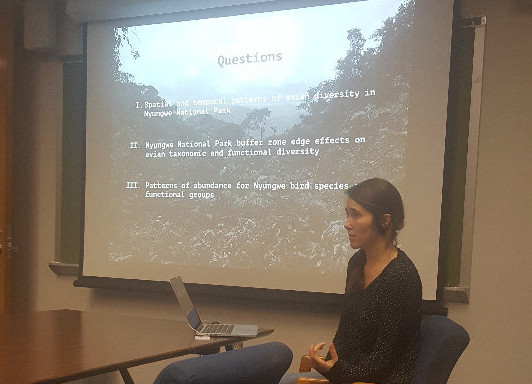On Wednesday December 7th, Dr. Elise Morton gave a SASA lunch talk titled, “Avian Diversity and Conservation in Nyungwe National Park.” Morton is a doctoral student in Wildlife Ecology & Conservation at UF, co-advised by Madan Oli and Scott Robinson. She also holds a PhD in Microbiology & Genetics from Indiana University. The talk focused on avian biodiversity in the Nwungwe National Park in southwest Rwanda, including Morton’s research plan for tackling questions related to spatial and temporal patterns of avian diversity, buffer zone edge effects on avian taxonomic and functional diversity, and patterns of abundance for Nyungwe bird species and functional groups.
Morton’s presentation opened with a series of descriptive slides explaining the ecological and economic value of Nyungwe National Park within the context of Rwanda. Important factors contributing to the region’s vulnerability include high population density, high levels of poverty, large population growth, and ongoing conflict in East Africa, all of which put increased pressure on preserved landscapes in the area and their associated biodiversity. Nyungwe National Park, a largely montane-rainforest environment, is part of the Albertine rift which contains 47% of all bird species found on the continent of Africa. There are over 300 bird species in the park including 25 endemic species, of which 7 are either endangered, vulnerable, or near-threatened.
Morton’s own research uses an impressively comprehensive bird monitoring dataset collected by the Wildlife Conservation Society which dates back to 1997 and contains over 92,000 observations of 203 different species. Some of the species of birds in the park are transient while others are part of the core population, and it is the core populations which are predicted to be more susceptible to local pressures on the park. Furthermore, species in tropical montane ecosystems that are restricted in their altitudinal range are predicted to be especially vulnerable to changing climate and Morton’s preliminary analyses suggest that communities at higher elevations have changed more than those at lower elevations.
Finally, her research considers the effects of tea, pine, and eucalyptus tree plantations which function as buffer zones separating park land from community land/farms. These buffer zones delineate park boundaries, discourage wildlife from crossing out of the park, mitigate crop raiding, and provide resources to local communities. They also offer the potential to preserve ‘microhabitats’, protecting edge species from changes in climatic factors while supporting species that are less specialized. Morton is interested in examining the degree to which different types of buffers affect forest communities with the hope that her results will inform on best management practices.